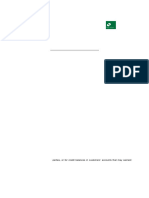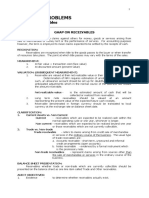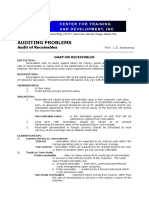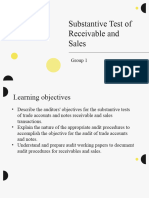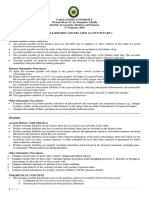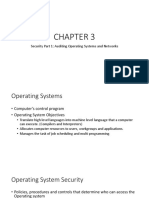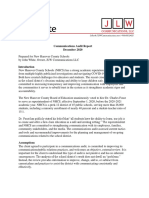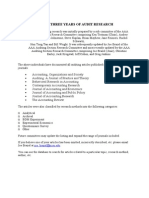0 ratings0% found this document useful (0 votes)
20 viewsAcaud Receivables
Acaud Receivables
Uploaded by
minghaoauditing reviewer
Copyright:
© All Rights Reserved
Available Formats
Download as DOCX, PDF, TXT or read online from Scribd
Acaud Receivables
Acaud Receivables
Uploaded by
minghao0 ratings0% found this document useful (0 votes)
20 views4 pagesauditing reviewer
Original Title
ACAUD RECEIVABLES
Copyright
© © All Rights Reserved
Available Formats
DOCX, PDF, TXT or read online from Scribd
Share this document
Did you find this document useful?
Is this content inappropriate?
auditing reviewer
Copyright:
© All Rights Reserved
Available Formats
Download as DOCX, PDF, TXT or read online from Scribd
Download as docx, pdf, or txt
0 ratings0% found this document useful (0 votes)
20 views4 pagesAcaud Receivables
Acaud Receivables
Uploaded by
minghaoauditing reviewer
Copyright:
© All Rights Reserved
Available Formats
Download as DOCX, PDF, TXT or read online from Scribd
Download as docx, pdf, or txt
You are on page 1of 4
INTRODUCTION the sales invoice.
Prices, quantity and payment
terms are reviewed before the sales invoice is
The revenue cycle is the set of activities that brings sent to the customer.
about delivery of goods or services to customers, who
ultimately pay in cash. 5. The daily totals of sales invoices processed
should be transmitted to the accounting
This cycle is composed of two phases: department for the proper journal entries in the
1. Physical phase - goods or services are sales journal and postings to the general ledger
delivered to the buyer and subsidiary ledger of accounts receivable.
2. Financial phase - the buyer makes payment for Any adjustments to sales, such as sales
goods and services delivered. discounts and sales returns and allowances,
must be properly approved before they are
The revenue cycle is described in the following recorded in the books.
sequential activities:
1. receiving purchase order from customer, 6. Daily totals of cash receipts from customers
2. checking inventory status, must be transmitted to the accounting
3. obtaining credit approval, department for proper posting to the subsidiary
4. preparing shipping and packing documents, ledger accounts.
5. shipping the goods and verification of 7. At least once a month, the total of the subsidiary
shipments, ledger balances should be reconciled with the
6. preparing the sales invoice, controlling account in the general ledger by an
7. sending statements to customers and receiving employee from the internal audit group or
payment. operations control group.
INTERNAL CONTROLS 8. Statements of accounts should be sent to
Internal control over sales transactions is best achieved customers, at least once a month.
by having separate departments (or individuals) 9. Dormant accounts should be reviewed and
responsible for the set of activities in the revenue cycle. tested for impairment. Approval shall be made
for writing off receivables assessed to be
An entity has to segregate the functions of transaction uncollectible.
authorization, record keeping and custody of asset. In 10. Accounts written off should be transferred to a
companies where it is not practical to separate such separate ledger and control account, for proper
duties, increased supervision is an alternative. control.
The revenue cycle: AUDIT OBJECTIVES
1. Preparation of the sales order which specifies The auditor’s principal objectives in the audit of
the terms of the customer’s order for guidance accounts receivable and sales are to:
by stores or warehouse department and the - Consider internal control over receivables and
shipping department. Such sales order is subject revenue transactions;
to the approval of the credit department (for - Determine the existence of receivables, that the
sales on account). client has rights to these assets, and the
occurrence of revenue transactions;
2. The approved sales order is forwarded to the - Establish the completeness of recorded
stores department for the issuance of the goods receivables and revenue transactions;
to the shipping department. - Determine that the receivables are measured at
3. The shipping department prepares a shipping appropriate; and,
document and forwards the goods to the - Establish that the presentation and disclosure of
common carrier, which in turn, issues a bill of receivables and revenues are appropriate.
lading.
4. A copy of the shipping document is transmitted AUDIT PROCEDURES
to the billing department for the preparation of
The auditor has to update information on client business reporting period. The cutoff period is usually several
risk and analyze potential motivations to or days before and after the end of the reporting period.
circumstances that misstate revenues. The auditor must The extent of cutoff tests depends on the strength or
understand client operations and identify the proper effectiveness of client controls over the revenue cycle.
revenue recognition principle applicable to business ❖ In sales cutoff test, the auditor selects sample of
operations. sales recorded during the last few days of the
year and first few days subsequent to the year
The recognition and measurement of revenues giving under audit.
rise to receivables are within the scope of IFRS 15, ❖ The recorded sales in the sales journal are
which became effective starting January 1, 2018. The vouched back to sales invoice and shipping
resulting receivables are financial assets that are within documents to determine whether sales are
the scope of IFRS 9 Financial Instruments. recorded in the proper period. The auditor also
examines the terms of the sales contract.
In relation to revenue and receivables, an ❖ In sales return cutoff, the auditor selects sample
understanding of the entity’s operations and its of receiving reports issued during the last few
environment will assist the auditor in developing: days of the year (or the last month of the year)
a. An expectation of total revenues by and during the first few days of the subsequent
understanding the company’s products, markets year (or the first month of the subsequent year).
and its maximum sales volume; ➢ The purpose is to determine whether the
b. An understanding of gross margins by credit memorandum is recorded during
understanding products, market share and the correct reporting period.
competitive advantage; and, ❖ In cash receipts cutoff test, the auditor selects
c. An expectation of receivable levels based on sample of credits to the accounts receivable in
average collection periods for the client and the the cash receipts journal and vouch them to the
industry as a whole. copies of official receipts issued during the cutoff
period and the copies of the sales invoices
Because of normal cutoff errors or misapplication of the issued to the customer.
appropriate revenue recognition principle, there is a ➢ The purpose is to determine whether
rebuttable presumption that the amount of revenue collection is recorded on time and
recorded by the enterprise contains some whether any adjustment in the original
misstatements. The presence of any of the following invoice price, if any, is properly
increases inherent risk and the probability of material accounted for.
misstatement:
a. Unusual credit terms; Examination of cash sales is linked to examination of
b. Unusually large amounts of revenues recorded cash receipts from such sales. Random samples of
towards the end of the reporting period; cash sales, based on sales invoice, can be traced to the
c. Sales made with recourse or that have cash receipts records and reconciled with bank
significant returns; deposits. Pricing must be checked to inventory records.
d. Unusual concentration of sales made to - To test reasonableness of the recorded cash
particular customers; and, sales, expectations are set for change in sales
e. Shipments to customers without corresponding figures in comparison with previous years’ sales.
sales orders. An amount beyond the expectations may require
further analysis and investigation.
Substantive tests of revenue for existence, occurrence
and valuation include vouching of recorded sales Similar attention must be given to credit sales. A sample
transaction back to customer order and shipping of sales invoices must be traced to the order slips (or
document. Quantities on customer’s order must be similar documents), reconciled to pricing information,
compared with quantities shipped and billed. warehouse requisitions and delivery receipts.
- The auditor has to obtain reasonable assurance
Cutoff tests can be performed for sales, sales returns that the credit sale was recorded in the proper
and cash receipts. Cutoff test provides evidence reporting period, that is when the sale is actually
whether transactions are recorded in the proper made.
include tracing subsequent cash receipts to
To obtain assurance that all shipments are billed, the determine that payments relate to the year-end
auditor should obtain a sample of shipping documents accounts receivable balance and reviewing
issued during the year and compare them to sales shipping documents to determine that accounts
invoices. receivable balances relate to goods ordered by
- To establish correctness of the balance of the customers which have been shipped. Matching
accounts receivable in the general ledger, it is these collections with the year-end receivables
necessary for the auditor to obtain a list of the addresses the assertions of existence, validity
accounts receivable from the subsidiary ledgers and collectability of these receivables, while
and reconcile the total to the balance in the reviewing shipping documents addresses the
general ledger. assertions of completeness, existence and
validity.
As a standard audit procedure, accounts receivable
must be confirmed. Negative confirmation is less expensive because non-
- Confirmation with debtors provides assurance response is assumed to mean agreement with the
that no lapping or any other form of manipulation balance in the confirmation request.
has been resorted to by any employee of the - Negative confirmations, therefore, may only be
entity. used when all of the following conditions are
- The auditing firm must mail directly the present: the account consists of a large number
confirmation request, with attached business small balances, the inherent and control risk for
reply envelope, to the client’s customers. accounts receivable is low, and the auditors
have no reason to believe that the customer will
Customers are requested to send back the reply to the not disregard the confirmation request.
auditing firm to eliminate any opportunity for client
employee to alter such reply. Non-agreement by the customer on amount indicated in
- Confirmations provide reliable external evidence the confirmation request is referred to as exception.
about the existence of recorded accounts - Exceptions may be due to timing differences in
receivable, completeness and correctness of the execution and recording of transaction,
recorded cash collections, sales discounts and disputed item of goods, customer errors or client
sales returns and allowances. errors.
- The auditor has to evaluate whether to use the - The auditor must determine the reason for
positive form or the negative form of exception, otherwise unexplained differences
confirmation. noted by the customers and significant time lag
- The positive form of confirmation requests the between the record of the customer and the
customer to reply whether or not the customer record of the client for cash remittances may
agrees with the amount indicated in the lead to a conclusion that fraud exists in the
confirmation request. collection process.
- The negative confirmation requests the debtor to
reply only when the balance shown is incorrect. To establish collectability of the receivables, the auditor
- Positive confirmations provide more competent has to review credit collection policies and procedures
evidence, because some customers may not and measure expected credit losses.
give due considerations to negative - Under IFRS 9, expected credit losses are
confirmation, thus nonreply does not necessarily recognized by setting up an allowance account
mean that the customer agrees with the balance at an amount equal to 12-month expected credit
indicated. Because positive confirmation losses and lifetime expected credit losses.
requires a response, it may be necessary to mail - Lifetime credit losses and the related loss
a second request if customer does not respond allowance are recognized for receivables whose
to the first confirmation request. credit risk increased significantly from the date
- Repeated non-reply will mean that the auditor of initial recognition.
has to use alternative procedures to verify the
existence and correctness of the balance of the Difficulty by the client in making collections on time,
customer’s account. Such procedures should repeated defaults by client’s customers, and
subsequent declaration of customers’ bankruptcy are receivable subsidiary ledger and trial balance
some indicators of lifetime credit losses on the and inquiries from management.
receivables. - The names of related parties must be
- For all other receivables with no such indicators communicated to all the members of the audit
of lifetime credit risk, an allowance for credit team so that they are alerted for related party
losses is measured at an amount equal to 12- transactions.
month expected credit risk.
Receivables that are sold with recourse, discounted or
The measurement of expected credit risk normally pledged as collateral can be identified through
involves classification of receivables by age. management inquiry, scanning cash receipts journal for
- The client normally prepares an aging schedule large inflows from unusual sources, bank confirmations,
manually or from a computerized system, of which include information on obligations and terms and
accounts receivable at the reporting date. reviewing the minutes of the meetings of the board of
- The auditor uses this aging schedule and group directors.
receivables according to age to evaluate the
adequacy of the client’s allowance for
uncollectible accounts.
- If the aging schedule is generated by the client,
the auditor has to test it for mathematical and
age classification accuracy.
- Other than for estimating the uncollectible
accounts, the aging schedule can be used to
validate the control account balance, select
customer accounts for confirmation, and identify
amounts due from related parties (for disclosure
purposes).
- In addition to the aging of accounts receivable,
the auditor may also examine credit files for
large accounts, review subsequent collections of
accounts and perform analytical procedures
useful in evaluating the appropriateness of the
balance of the allowance for uncollectible
accounts.
Substantive tests on notes receivable and related
interest revenue include inspection of the notes,
independent computation of interest earned and
analytical review procedures.
- Notes must be examined as to date of maturity,
interest rate and payee.
- The most effective verification of interest
revenue account consists of test of
reasonableness of interest earned during the
year on notes receivable. Ratios and trends can
be used as indicators of reasonableness of
amounts.
Receivables from related parties should be separately
disclosed.
- Audit procedures that identify related party
transactions include reviewing the accounts
You might also like
- Audit - Sales and ReceivablesDocument6 pagesAudit - Sales and ReceivablesValentina Tan DuNo ratings yet
- (AP) Sales and ReceivablesDocument13 pages(AP) Sales and Receivableschiara uyNo ratings yet
- Chapter 5Document20 pagesChapter 5temedebereNo ratings yet
- AUD02 - 02 Transaction CyclesDocument54 pagesAUD02 - 02 Transaction CyclesMark BajacanNo ratings yet
- Audit Ii CH-2Document32 pagesAudit Ii CH-2GetnetNo ratings yet
- Chapter 3 & 4Document18 pagesChapter 3 & 4Tesfahun tegegnNo ratings yet
- 2077 - Varias, Aizel Ann B. - Module 2Document3 pages2077 - Varias, Aizel Ann B. - Module 2Aizel Ann VariasNo ratings yet
- Auditing Problems: Audit of ReceivablesDocument4 pagesAuditing Problems: Audit of ReceivablesLaong laanNo ratings yet
- AP Lesson 2Document13 pagesAP Lesson 2Joanne RomaNo ratings yet
- Auditing Problems: Audit of ReceivablesDocument4 pagesAuditing Problems: Audit of ReceivablesMa. Trixcy De VeraNo ratings yet
- Audit of ReceivablesDocument4 pagesAudit of ReceivablesClarisse AnnNo ratings yet
- Audit of The Sales and Collection Cycle: Tests of Controls Review Questions 12-1Document22 pagesAudit of The Sales and Collection Cycle: Tests of Controls Review Questions 12-1Tilahun MikiasNo ratings yet
- Module 4 RECEIVABLES AND RELATED REVENUESDocument5 pagesModule 4 RECEIVABLES AND RELATED REVENUESNiño Mendoza MabatoNo ratings yet
- Audit of Collection CycleDocument9 pagesAudit of Collection Cycle202220012No ratings yet
- IC3 Audit Procedures by Transaction Cycle Part 1Document12 pagesIC3 Audit Procedures by Transaction Cycle Part 1ReynaLyn TangaranNo ratings yet
- Chapter Three-Auditing Receivables and SalesDocument4 pagesChapter Three-Auditing Receivables and SalesBantamkak Fikadu100% (1)
- Audit ObjectiveDocument23 pagesAudit ObjectiveTrần Bảo YênNo ratings yet
- Zelalem G. Audit II CHAP - THREE AUDIT OF RECIVABLE AND SALEDocument3 pagesZelalem G. Audit II CHAP - THREE AUDIT OF RECIVABLE AND SALEalemayehuNo ratings yet
- Internal Controls For The Accounting Function (Contd.) : 1.examples of Accounting SubsystemsDocument31 pagesInternal Controls For The Accounting Function (Contd.) : 1.examples of Accounting Subsystemsraina mattNo ratings yet
- Compre - Quiz2 Business - Processes5.24.2024Document9 pagesCompre - Quiz2 Business - Processes5.24.2024fermahilomNo ratings yet
- Revenue CycleDocument34 pagesRevenue Cyclelailadaniel12No ratings yet
- Chapter 2Document7 pagesChapter 2Jarra AbdurahmanNo ratings yet
- CH 3 Audit IIDocument21 pagesCH 3 Audit IIsamuel debebeNo ratings yet
- Application of The Risk-Based Audit Process Test of Controls and Substantive Tests of Transactions and Details of Balances, and ReportingDocument57 pagesApplication of The Risk-Based Audit Process Test of Controls and Substantive Tests of Transactions and Details of Balances, and ReportingHannah SyNo ratings yet
- Arens AAS17 SM 14Document10 pagesArens AAS17 SM 14ahmed alamriNo ratings yet
- Chapter 14Document30 pagesChapter 14Tumpal Sagala100% (1)
- AttachmentDocument14 pagesAttachmentAngelo Jose BalalongNo ratings yet
- Audit G1Document73 pagesAudit G1Jasmine ManuelNo ratings yet
- Audit of LiabilitiesDocument9 pagesAudit of LiabilitiesI Am Not Deterred100% (2)
- Jawaban CH 14Document28 pagesJawaban CH 14Heltiana NufriyantiNo ratings yet
- Jawaban CH 14Document28 pagesJawaban CH 14Heltiana Nufriyanti80% (5)
- Audit of ReceivablesDocument15 pagesAudit of ReceivablesLouie De La Torre75% (4)
- Audit of ReceivableDocument26 pagesAudit of ReceivableHannah AngNo ratings yet
- Chapter 19 AnswerDocument19 pagesChapter 19 AnswerMjVerbaNo ratings yet
- Accounts Receivable Notes Receivable RevenueDocument11 pagesAccounts Receivable Notes Receivable RevenueVatchdemonNo ratings yet
- Audit of Receivables-1Document16 pagesAudit of Receivables-1jennyMBNo ratings yet
- Financial Statements - NewDocument23 pagesFinancial Statements - NewLawraNo ratings yet
- Stock Audit PresentationDocument27 pagesStock Audit PresentationShan BsmaniNo ratings yet
- Module 2 For Acctg 3119 - Auditing and Assurance PrinciplesDocument57 pagesModule 2 For Acctg 3119 - Auditing and Assurance PrinciplesAdeline DelveyNo ratings yet
- Auditing Lecture Notes 04172022Document16 pagesAuditing Lecture Notes 04172022Abegail Cadacio100% (2)
- At.3511 - Specific Audit Procedures (Part 1)Document5 pagesAt.3511 - Specific Audit Procedures (Part 1)John MaynardNo ratings yet
- Audit of ReceivablesDocument3 pagesAudit of ReceivablesJhedz CartasNo ratings yet
- 2024 - For Merge1Document17 pages2024 - For Merge1tigistdesalegn2021No ratings yet
- Chapter 5 Audit - SummaryDocument22 pagesChapter 5 Audit - SummaryCabdixakiim-Tiyari Cabdillaahi AadenNo ratings yet
- Kunci Jawaban Auditing Chapter 14 Arens 15th EditionDocument8 pagesKunci Jawaban Auditing Chapter 14 Arens 15th EditionArfini Lestari100% (2)
- Book SolutionDocument5 pagesBook SolutionJ. EDUNo ratings yet
- ACCTG16A FinalExamDocument5 pagesACCTG16A FinalExamJeane BongalanNo ratings yet
- How Do Different Levels of Control Risk in The RevDocument3 pagesHow Do Different Levels of Control Risk in The RevHenry L BanaagNo ratings yet
- Unit 6Document12 pagesUnit 6fekadegebretsadik478729No ratings yet
- Chapter 6Document8 pagesChapter 6Jesther John VocalNo ratings yet
- CH-2 Audit of Sales and Collection CycleDocument21 pagesCH-2 Audit of Sales and Collection CycleAyana Giragn AÿøNo ratings yet
- Chapter 14 Audit of The Sales and Collection CycleDocument8 pagesChapter 14 Audit of The Sales and Collection CycleAaqib HossainNo ratings yet
- Module 1 - Audit of CashDocument24 pagesModule 1 - Audit of CashGerma CosepNo ratings yet
- Luxury HomeworkDocument4 pagesLuxury Homeworkyms122874No ratings yet
- Purchasing, Inventory, and Cash Disbursements: Common Frauds and Internal ControlsFrom EverandPurchasing, Inventory, and Cash Disbursements: Common Frauds and Internal ControlsRating: 4.5 out of 5 stars4.5/5 (2)
- Intermediate Accounting 1: a QuickStudy Digital Reference GuideFrom EverandIntermediate Accounting 1: a QuickStudy Digital Reference GuideNo ratings yet
- Bookkeeping And Accountancy Made Simple: For Owner Managed Businesses, Students And Young EntrepreneursFrom EverandBookkeeping And Accountancy Made Simple: For Owner Managed Businesses, Students And Young EntrepreneursNo ratings yet
- Mastering Bookkeeping: Unveiling the Key to Financial SuccessFrom EverandMastering Bookkeeping: Unveiling the Key to Financial SuccessNo ratings yet
- Kerala Budget Manual Preparation of Budget Part I and II - Revised EstimatesDocument17 pagesKerala Budget Manual Preparation of Budget Part I and II - Revised EstimatesSmitha SreehariNo ratings yet
- Senior Analyst Manager Strategic Sourcing in Irvine Orange County CA Resume Vivienne StrettenDocument2 pagesSenior Analyst Manager Strategic Sourcing in Irvine Orange County CA Resume Vivienne StrettenVivienne StrettenNo ratings yet
- Security Part 1: Auditing Operating Systems and NetworksDocument9 pagesSecurity Part 1: Auditing Operating Systems and NetworksJoan Marie GeronNo ratings yet
- Audit MCQ NewDocument11 pagesAudit MCQ NewGT Moringa LimitedNo ratings yet
- SMETA BPG Private Employment Agencies Audits Pilot Terms of Reference 080514 Final PDFDocument2 pagesSMETA BPG Private Employment Agencies Audits Pilot Terms of Reference 080514 Final PDFChrisa KargiotouNo ratings yet
- REVISED ONE DTI SECOND SURVEILLANCE AUDIT REPORT - ROs and BureausDocument230 pagesREVISED ONE DTI SECOND SURVEILLANCE AUDIT REPORT - ROs and BureausJonathan LarozaNo ratings yet
- C2 Carl DunkleyDocument34 pagesC2 Carl DunkleyAnonymous iI88LtNo ratings yet
- University of San Carlos: School of Business and EconomicsDocument3 pagesUniversity of San Carlos: School of Business and EconomicsVenn Bacus RabadonNo ratings yet
- AIS - Chap 7 Questions (Finals)Document8 pagesAIS - Chap 7 Questions (Finals)KathleenCusipagNo ratings yet
- Arens14e ch11 PPTDocument35 pagesArens14e ch11 PPTCesar Samuel RomuloNo ratings yet
- CB1 - September22 - EXAM - Clean ProofDocument7 pagesCB1 - September22 - EXAM - Clean ProofboomaNo ratings yet
- ISO 9001 Lead Auditor Sample Exam Questions and AnswersDocument8 pagesISO 9001 Lead Auditor Sample Exam Questions and Answersaymanawad016No ratings yet
- ASC Salmon Standard v1.4 FinalDocument103 pagesASC Salmon Standard v1.4 FinalAlfredo NavarroNo ratings yet
- NHCS Communications Audit 2020-2021Document16 pagesNHCS Communications Audit 2020-2021Ben SchachtmanNo ratings yet
- 33 Yrs Audit Research FinalDocument133 pages33 Yrs Audit Research FinalRatna Saridewi100% (1)
- DeloitteZA KingIV Bolder Than Ever CGG Nov2016Document20 pagesDeloitteZA KingIV Bolder Than Ever CGG Nov2016Philile NkwanyanaNo ratings yet
- Audit and Internal ReviewDocument5 pagesAudit and Internal ReviewkhengmaiNo ratings yet
- Recycled Content Traceability Certification Procedures and QMS 2020 2020 10 07Document11 pagesRecycled Content Traceability Certification Procedures and QMS 2020 2020 10 07OrmeneNo ratings yet
- Artikel Internasional (Embedding Process Mining Into Financial Statement Audits)Document15 pagesArtikel Internasional (Embedding Process Mining Into Financial Statement Audits)ERIN ARIANI Br SurbaktiNo ratings yet
- Human Resource Management Practices and Their Influence On Service Delivery Among The State Corporations in KenyaDocument15 pagesHuman Resource Management Practices and Their Influence On Service Delivery Among The State Corporations in KenyaIJAR JOURNALNo ratings yet
- f8 Revision Essentials - 25Document164 pagesf8 Revision Essentials - 25Rab Khan100% (2)
- Workshop Week 9 SolutionsDocument9 pagesWorkshop Week 9 SolutionsAssessment Help SolutionsNo ratings yet
- P7mys 2007 Dec Q 3Document8 pagesP7mys 2007 Dec Q 3ThomasNo ratings yet
- Auditor Evaluation Form 2018Document2 pagesAuditor Evaluation Form 2018nesliebarramedaNo ratings yet
- Chapter 21Document17 pagesChapter 21213808itNo ratings yet
- Auditing The Financing/Investing ProcessDocument34 pagesAuditing The Financing/Investing ProcessLucilleDeVilleNo ratings yet
- Compliance RegulatoryDocument10 pagesCompliance Regulatorynur_haryantoNo ratings yet
- Customer Relati-WPS OfficeDocument7 pagesCustomer Relati-WPS OfficePrasad PNo ratings yet
- Deloitte - COSO III 2013 - Lunch PresentationDocument27 pagesDeloitte - COSO III 2013 - Lunch PresentationAnkur MittalNo ratings yet
- Forensic Audit: Introduction / OverviewDocument4 pagesForensic Audit: Introduction / OverviewKushal BaidNo ratings yet

